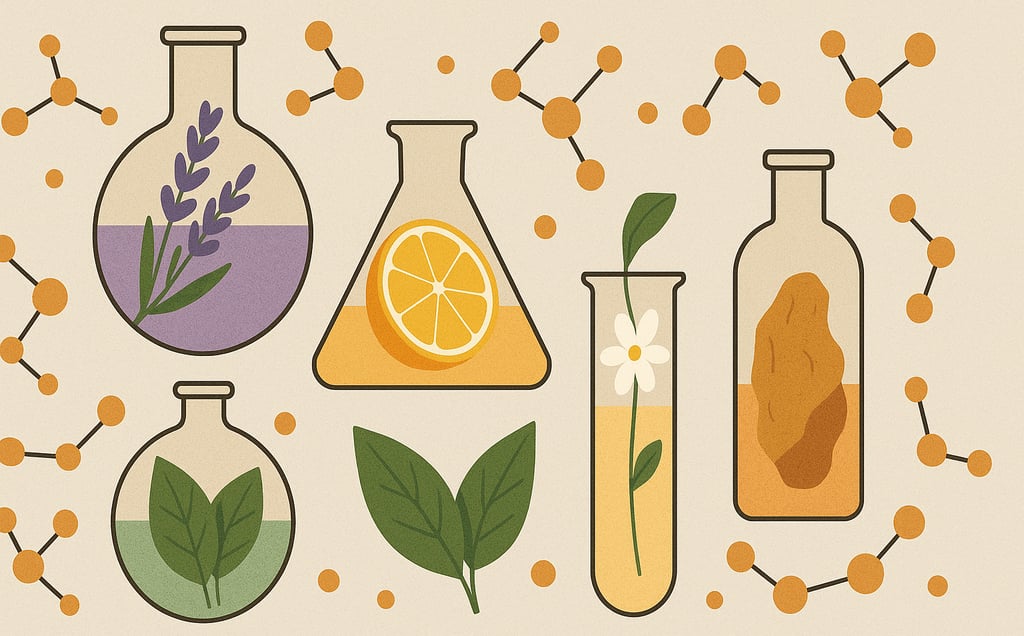The Molecules that Rule the Fragrance World
Do you know about that hard-working cast of molecules that shape the scents that you buy? Here, we go through Linalool, Limonene, Iso E Super, Hedione and Ambroxan. Molecules that our olfactory senses pick up so often, yet goes under our radar.
THE SCENT DAILY
6/18/20257 min read


Scratch beneath that romance of perfumery and you’ll find a hard-working cast of aroma molecules doing most of the lifting. Some are plucked straight from flowers or citrus rinds, others are made in laboratories to solve problems nature never needed too. Characteristics like longer wear, better diffusion, stricter safety limits, tighter supply chains. Out of the thousands on a perfumer’s palette, only a handful dominate day-to-day formulas for fine fragrance, personal-care products, home scents, even laundry beads. They dominate because they tick the three big boxes of fragrance. Olfactive use, versatility and cost-efficient supply.
This article will explain the five molecules that see the heaviest real-world use today. Each section sketches the molecule’s scent profile, explains why perfumers reach for it, and looks at the market forces or regulatory quirks that keep it on top. Although naturals like rose absolute or sandalwood oil still enthrall, the following pages show that modern perfumery is, at heart, a story of Linalool, Limonene, Iso E Super, Hedione and Ambroxan. These molecules are ones that, quite literally, rule the fragrance world.
Linalool - The Floral
If you smell lavender, it’s probably Linalool. This molecule is the quiet engine behind countless floral perfumes and nearly every bottle of lavender-scented anything. Chemically a monoterpene alcohol, it occurs naturally in more than 200 plant species from lavender spikes to coriander seed. Yet 21st-century demand is met largely by industrial production that keeps the price predictable and the purity consistent. Global revenue stood at roughly USD 660 million in 2024, with a steady 4 % annual growth forecast through 2032 as personal-care markets expand in Asia-Pacific.
Why do perfumers reach for it so often? First, the smell: linalool delivers a transparent, slightly sugary floral note that feels recognizably “clean” to most noses. That neutrality lets it act as a connective tissue between brighter top notes (bergamot, petit-grain) and creamy bases (musk, vanillin). Second, it synergizes really well with other accords. Just a few percent boosts the lift of citrus accords and the radiance of jasmine, making other ingredients work harder. Trade formularies even list it as a mild fixative, extending the life of more volatile materials without darkening the composition.
Regulators keep a close eye on linalool because it can oxidize into skin sensitizers. The EU and IFRA therefore impose concentration caps in rinse-off and leave-on products. Yet those limits scarcely dent its dominance. Formulators simply offset with antioxidants, nitrogen-flush drums, or smart packaging. Consumers, meanwhile, vote with their wallets for “natural-sounding” ingredients which is exactly the image linalool projects. Industry analysts note that demand from deodorants, shower gels and air-care products shows no sign of plateauing.
Finally, supply security matters. Linalool can be synthesized from renewable pine or camphor streams, avoiding reliance on any single flower crop. That makes it a textbook example of a molecule whose popularity rests on equal parts aroma appeal and ease of production. When you catch a waft of lavender detergent or citrus-laced cologne, chances are the smooth bloom that pulls everything together is linalool doing its job.
D-limonene - The Citrus
If linalool whispers in the background, limonene shouts in the foreground. The terpene that gives orange peels their zing is the planet’s go-to citrus note, accounting for a sizable share of the USD 17 billion fragrance-ingredients market. Analysts attribute its rise to two converging trends: consumers equate citrus with “fresh and clean,” and the food-juice industry supplies limonene-rich waste streams that can be up-cycled into fragrance grade material at attractive margins.
Olfactively, limonene flashes bright, sweet and tangy. Perfumers dose it high in top notes to create an immediate burst of freshness, then anchor it with slower-evaporating companions such as ionones or petite woods. Its volatility is both strength and weakness. The fizz delights on first spray but can vanish within minutes unless trapped by fixatives. Modern formulas therefore tuck limonene inside cyclodextrins or micro-capsules to stretch its lifespan in fabric softeners and household cleaners.
Regulatory pressure differs from that on linalool. Limonene is also an oxidation-prone sensitizer, yet its status as a food-grade flavor additive helps maintain consumer confidence. The bigger concern is sustainability. While citrus-juice demand supplies raw material today, climate-related crop disease (citrus greening) threatens long-term yield. That has spurred biotech firms to ferment limonene from sugarcane residues. This provides a safety net for the next decade’s growth curve.
Technically, limonene is chiral, existing in D- and L-forms. The perfume world overwhelmingly exploits D-limonene for its sweet-orange sparkle, but niche brands sometimes play with L-limonene’s greener, pine-camphor character to craft unexpected twists. Albeit, L-limonene is much less popular than its counterpart. Either way, perfumers value limonene as the olfactory exclamation mark that wakes up sleepy compositions.
We actually wrote an article that goes more in depth about D-Limonene. You can view it here.
Iso E Super - The Velvet Wood
In the mid-1970s, International Flavors & Fragrances (IFF) launched Tetramethyl Acetyloctahydronaphthalenes under the trade name Iso E Super. The molecule didn’t smell like an obvious hit. But its magic lay in the silky halo it cast around other notes. Fast-forward to 2025 and market researchers estimate that nearly 30 % of all synthetic fragrance ingredients now contain Iso E Super in some proportion.
Olfactively, Iso E Super combines a cedar-like dryness with a faintly ambery warmth. More important is its diffusion. It radiates off skin in soft pulses for eight hours yet never overwhelms. Perfumers exploit that radiance to knit top, heart and base together without obvious seams. In functional fragrances like detergents, fabric sprays, the molecule survives harsh wash conditions and leaves textiles smelling subtly “laundered” days later.
The 2006 launch of Escentric Molecules’ Molecule 01, a perfume containing Iso E Super, made the ingredient much more popular. On the safety front, Iso E Super enjoys a relatively smooth ride. IFRA permits generous limits because clinical data show low sensitization potential compared with many naturals. That regulatory head-room allows creative overdosing which also drives demand. Sustainability, too, comes easily. Petrochemical and renewable feed-stocks both work in producing it, and the process consumes less energy than isolating sandalwood oil.
Perhaps the most telling metric is that “wood” accords in contemporary perfumery often list no real woods at all but just Iso E Super plus a pinch of cedrol derivatives. When you catch a velvety, pencil-shaving undertone in a modern designer fragrance, chances are you’re smelling this molecule.
Hedione - The Jasmine
Discovered at Firmenich in 1957 and first showcased in Dior’s Eau Sauvage (1966), methyl dihydrojasmonate introduced an airy, diffusive quality no natural extract could match. Half a century later, retailers of raw materials describe it as “probably the most widely used aroma chemical in all of perfumery.”
What makes Hedione special is its softness. Whereas natural jasmine absolute can feel indolic and animalic, Hedione floats. It’s transparent, slightly fruity, more like blossoms carried on a breeze than petals in your hand. Neuroscientists have shown that it even activates a human pheromone receptor, suggesting an evolutionary reason people find it “sparkling” or “addictive.” That subliminal appeal lets brands overdose Hedione without fatiguing the nose. Some summer-like Eau Fraîche use up to 35 % to keep the scent alive despite minimal base notes.
Technologically, Hedione excels at lift. It pairs with citrus to extend their life, brightens spices, and helps heavy resins feel less syrupy. Because it evaporates more slowly than limonene but faster than musks, it bridges the awkward gap between a fragrance’s opening and its lasting base. That bridging role explains why formulators slot Hedione into everything from budget shampoos to $500 niche extraits.
Supply never strays far from clary-sage-derived intermediates, so Hedione is considered secure against climate shocks that threaten rose or orange-flower crops. Environmental impact studies rate its aquatic toxicity as moderate, prompting IFRA concentration limits, yet those caps still allow perfumers to reach effective doses in most categories. Culturally, Hedione symbolizes a shift toward translucency. From Christian Dior to Byredo’s “Open Sky,” the presence of this molecule signals modernity. Even fragrances marketed as “raw” or “natural” quietly rely on Hedione to keep them from smelling muddy.
Ambroxan – The Ambergris
Natural ambergris, secreted by sperm whales and aged by the ocean, once ranked among perfumery’s rarest treasures. Ethical and cost barriers pushed chemists to seek alternatives, and in 1950 Firmenich introduced Ambrox (later Ambroxan), a lab-made lactone that recreates ambergris’ salted warmth. Today Ambroxan appears in hundreds of perfumes ranging from luxury brands to niche naturals, according to ingredient trackers, and is routinely labeled simply as “Parfum” on INCI lists.
The scent profile blends dry-woody facets, crystalline musk and a faint mineral sparkle often likened to hot beach stones. One of the greatest perks of Ambroxan is that it offers persistence. A 0.5 % trace can make an entire formula last hours longer. That longevity turned it into the backbone of blockbuster perfumes such as Maison Francis Kurkdjian’s Baccarat Rouge 540, whose saffron-and-sugar sheen rides on a large dose of Ambroxan. Fashion media now refer to the molecule as “ubiquitous,” noting its spread into candles, hair mists and laundry scent-boosters.
From a chemistry standpoint, Ambroxan is synthesized from sclareol, a compound found in clary-sage concrete. Using a renewable botanical feed-stock softens its carbon footprint versus petroleum-derived musks which is perfect for today as most brands are striving for sustainability. Replacing endangered ambergris also removes a contentious animal-derived ingredient from supply chains. Perfumers love that.
In terms of regulatory hurdles, it remains low. Ambroxan shows minimal allergenic potential, so IFRA permits generous usage. Cost, however, has risen with demand. Some smaller houses limit Ambroxan to 8-10 % of a formula to balance budget and effect, while big luxury brands often go higher. Also, since masculine fragrances have shifted from aggressive woods to smoother ambers often powered by Ambroxan, it has increased its demand. Bottom line, all signs indicate that, unless a cheaper or bolder amber emerges, Ambroxan will keep its throne.
Closing Thought
These molecules play an immense role in what we think and feel about a place. Smell represents about 20% of our senses which means a fifth of the sensory data that our brain takes in probably comes from smell. So, being able to control it with these molecules has helped in creating places that are that much more pleasant to be in. In accordance with that, I think it's only fair that we should at least know the names of these molecules, which have definitely, at least some time in our past and probably more times in the future, shaped what others think of us and our spaces.


